Joffre Lakes is busy—the stories are no exaggeration. But it’s busy for a reason: it has the rare distinction of being both stunning and accessible. It’s normally a day hike, but one also has the option of camping at Joffre Lakes.
In late September 2021, I had the opportunity to visit. I figured (wrongly) that the crowds might taper off a little as summer became autumn. I also figured (less wrongly) that camping overnight in the park would be a nice way to experience it with fewer people about.
Here’s my experience visiting Joffre Lakes Provincial Park in early autumn.
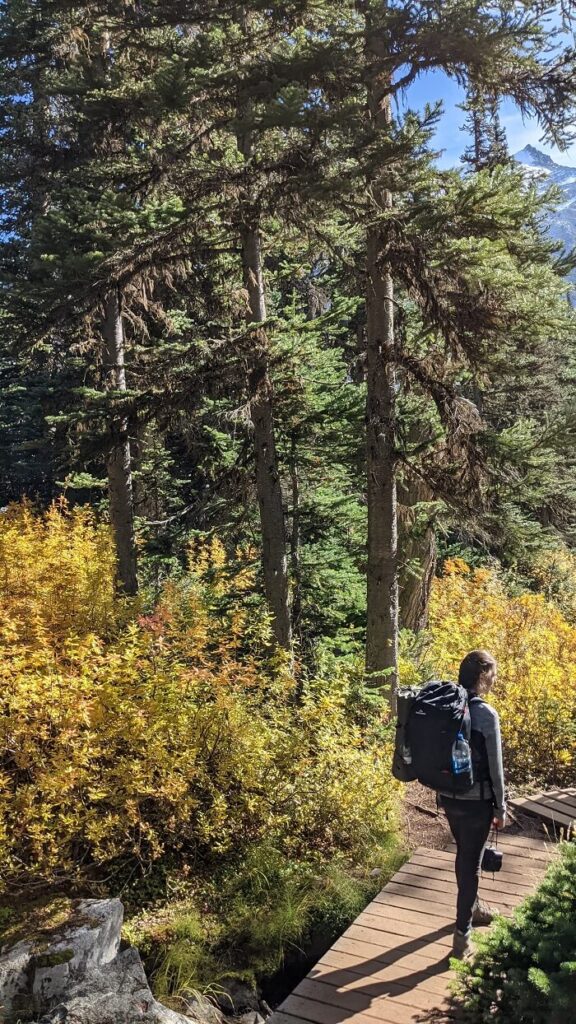
About Joffre Lakes
- Joffre Lakes lies about 2.5 hours (186 km) from downtown Vancouver. It’s 1 hour (62 km) from Whistler.
- It’s approximately 3.3 km to reach the main lake, and 5 km to reach the campground at the far side of the lake.
- The total elevation gain for the hike is 880 m. The highest point of the trail is 1,938 m above sea level. The trailhead is at 1,237 m above sea level.
- Joffre Lakes Provincial Park is located within the shared territories of the Lil’wat Nation and N’Quatqua and within the traditional territory of the St’at’imc people.
Planning the camping trip
As a silver lining to being stuck near home throughout 2020 and 2021, my partner and I took the opportunity to visit some long-neglected popular hikes throughout BC. Joffre Lakes was always on the wishlist. However, it wasn’t actually an option for a lot of that time—it was closed to visitors for 14 months from spring 2020 until summer 2021.
Upon the park’s reopening, visitors needed to secure a day pass (the system implemented for many popular BC parks in 2020). The day pass system is—at worst—mildly inconvenient, but anything that limits visitors to a sustainable number is fine by me.
But, the day pass system isn’t that limited; it’s not clear how many passes BC Parks gives out each day, but it’s most certainly multiple hundreds.
So, rather than fight the lesser-but-still-significant crowds, we figured we might as well try to grab a campsite at the only campground in the park. The hike is too short to require an overnight stay, but why not enjoy a relaxing one-night camping trip?
Day 1 – Hiking to Upper Joffre Lake
Knowing that parking tends to be nightmarish at Joffre Lakes, the plan was to arrive later in the day to snag a spot as someone else left. The parking lot just after noon was predictably packed, but the plan paid off.
It was impossible to be certain that the weather would cooperate for this late-September trip, but it did: nothing but sunshine and crisp autumn air for the entire first day.

Lower Joffre Lake, located basically next to the parking lot, is a good place to hang out for a bit and have lunch if you’re starting late in the morning or early in the afternoon. It’s a beautiful spot, and (at least for us) less crowded than any other beautiful spot on the trail.
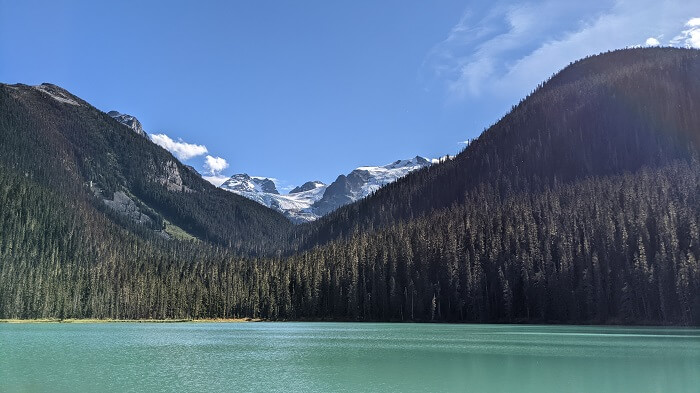
From there, the trail begins climbing upward.
The trail makes its way through the forest. There are occasional breaks in the trees, where one can see back across the valley to the lower slopes of Cayoosh Mountain.


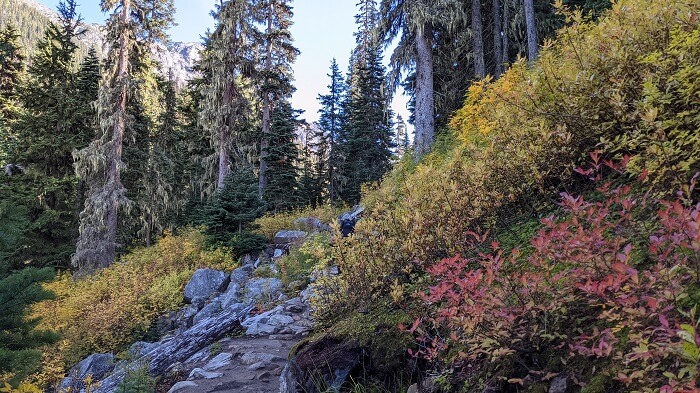
It’s not the most strenuous hike in the world, but it’s a steady rise for about 2.5 km until one reaches Middle Joffre Lake. This is one of the popular photo stops on the trail, and understandably so. It seemed as though many people came only to the middle lake and turned around.
Not us, though.
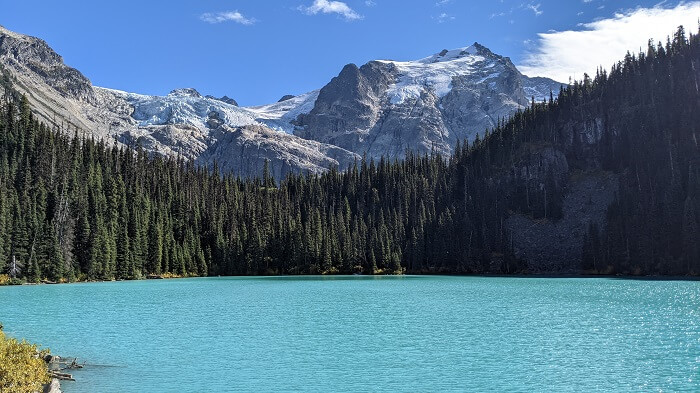
The trail winds around the eastern shore of the small lake. Then, it makes one last steep, short climb to Upper Joffre Lake, barely a full kilometre further. It’s well worth the extra effort to get up there.
One of the best views is from the spot where one first comes out of the trees onto the lake shore. Thanks to the clear, crisp weather, we had a phenomenal view across the turquoise lake to the Matier Glacier, flanked on either side by Mount Matier and Joffre Peak.

The trail continues along the lake’s western shore for another kilometre or so. This section was rough with full-size backpacks; a lot of it isn’t “trail” so much as “large rocks to climb over.” We (mostly I) made several wrong turns and clambered over far more rocks than was necessary. Oh well.
The Joffre Lakes campsite sits at the south side of the lake. It too is a rocky situation, and it was hard to figure out where the tent pads were. We located a few sort-of tent pads right at the lake shore, and claimed one.
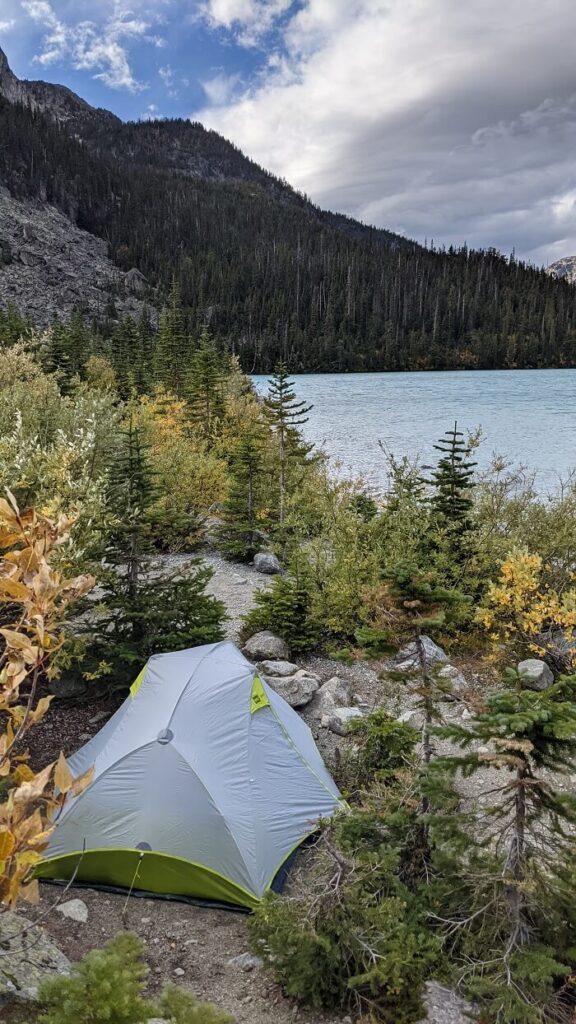
The trail actually continues past the campsite. It’s a steep, rocky trip up towards the glacier, and we saw several people in the distance that had made the climb. We went about half way up, but the early sunset of September made it seem unwise to keep going. Plus, the view even from a few hundred metres past the campground isn’t too shabby.
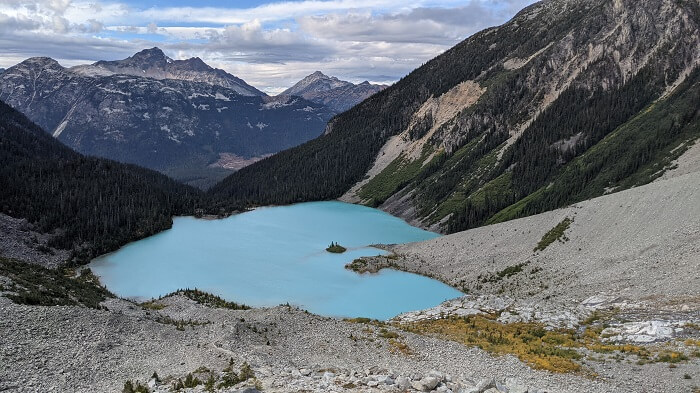
Camping for the night
As the sun set, the clouds began to roll in.
We’d checked the weather forecast beforehand, so we were well prepared for the prospect of overnight rain, and a wet hike out the following day.
The rain held off until after dinner at least. Warm food and hot tea were nice in the cool autumn evening, but by 6:00 or so it was already getting pretty dark—the kind of camping night where you can read a couple hundred pages in the tent, and still be asleep before 8:30.
The campground at Joffre Lakes doesn’t have many bells and whistles; there isn’t so much as a picnic table on which to set up a campstove. There are, however, a number of large, waist-height rocks that do in a pinch. After cooking and eating dinner while leaning against one of these rocks, it was bed time.
I woke a couple of times through the night to the sound of rain. Heavy rain.
Day 2 – A Wet Walk
The heavy rain hadn’t slowed down by morning. It wasn’t easy to drag ourselves out of the tent, but such is life. The rain did slow briefly just after we got up. In that short window of dryness, we were faced with the decision between packing up the tent or making some hot breakfast and coffee. I chose the coffee.
By the time that was finished, the rain had returned in full force and breaking camp was a miserable affair. Again, such is life.
The hike down from Joffre Lakes goes quickly, even in wet and slippery conditions. One thing about heavy rain: it certainly kept the crowds at bay. We did meet a few parties heading up despite the weather, but not the endless stream that was around the day before.
We were even able to stop at Middle Joffre Lake and enjoy some tranquility (though the view wasn’t as nice).
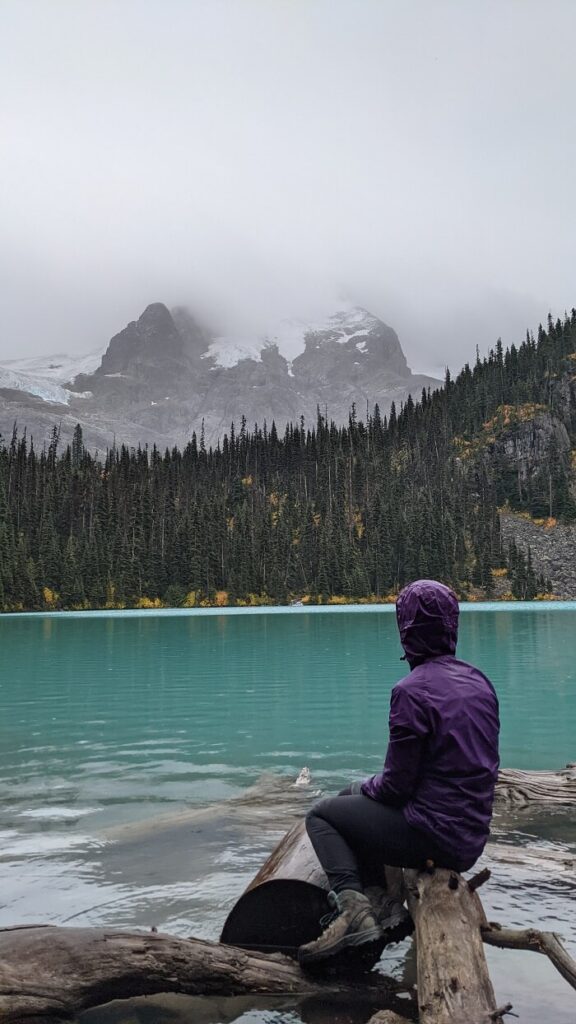
We got back to the parking lot (much emptier now) by mid-morning. Before 11:00, we had changed into dry clothes and driven to Pemberton for—what else?—more coffee.
Camping overnight at Joffre Lakes was a fantastic experience. It may not be necessary for a four-ish hour round trip, but why not? It’s a beautiful place, and staying overnight is the best way to experience it.
Questions or comments? Leave ’em below. Want to read another overnight backpacking story? Check out this story about the beautiful experience of camping at Elfin Lakes.


Excellent article Seamus and some beautiful pics. Thanks for sharing!
Thank you, Anthony!
Thanks how many of the pitches were used